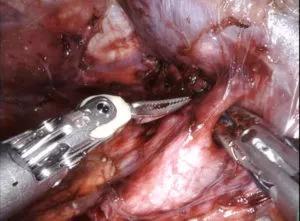Accessing the right side of the liver laparascopically involves several more challenges when compared to the left side of the liver

A 44-year-old patient had his primary colorectal cancer excised, but in follow-up he was found to have a suspicious area in the liver that was thought to have metastasized from the colorectal tumor. His case was presented at Cleveland Clinic’s multi-disciplinary tumor board, and the decision was to biopsy the area by radiology. Those results indicated the area on the liver was a result of the primary colorectal cancer spreading, and the tumor board recommended removing the right half of the liver. Eren Berber, MD, Director of Robotic Endocrine Surgery, Neuroendocrine / Adrenal Tumor Center, Surgical Liver Tumor Ablation Program and co-director of Multidisciplinary Liver Tumor Clinic, and Federico Aucejo, MD, Director of the Liver Cancer Program and Surgical Director of the Liver Tumor Clinic in the Department of General Surgery, decided to take a robotic approach to removing the right half of the liver. The surgery was successful, and the patient was discharged after three days of recovery. Follow-up pathology showed that complete removal of the tumor with clear margins.
Advertisement
Cleveland Clinic is a non-profit academic medical center. Advertising on our site helps support our mission. We do not endorse non-Cleveland Clinic products or services. Policy
Traditional liver surgery is performed through one open incision incision below the ribs or along the midline and takes a significant amount of recovery. Over the past 10 years, minimally invasive liver resection has emerged as a viable alternative. This robotic-assisted right-sided hepatectomy was the first one performed at Cleveland Clinic.
Dr. Berber notes that there are several benefits to performing hepatectomies robotically compared to the traditional method. “Because we’re able to do complex liver surgery laparoscopically through small incisions, the recovery period for the patient is shorter and the pain is less,” says Dr. Berber. “Then most recently, there is robotic liver resection. The benefits of robotic versus laparoscopic is that some of the surgical tasks are difficult to do laparoscopically. The robot approach enables you to do these tasks much more easily. For me, it’s almost as if you’re doing open surgery with your hands because the tools are articulating.”

Liver resections are categorized as minor resections, where a small portion of the liver is removed. A major liver resection is when half of liver or more is removed. “This case was a major liver resection,” explains Dr. Berber. “The major liver resection is also separated to left versus the right. And the right side of the liver is action is more challenging because of the tissue planes involved for a right-sided liver resection versus a left. We had done a robotic left liver resection in the past, but we had not done a right-sided liver resection robotically before. So this was the first robotic right-sided liver resection performed at Cleveland Clinic.”
Advertisement
For the right side of the liver, the surgeon has to divide the blood vessels going in and out of that segment of the liver that is being removed. Dr. Berber explains that these vessels are easier to access on left-sided liver resections. “A right-sided liver resection is much harder to access, and there are also more vessels involved for a right-sided resection,” says Dr. Berber. “The liver is lifted off the inferior vena cava, and the right side of the liver has multiple vessels draining into that vessel that are difficult to do laparoscopically.”

Cleveland Clinic’s Laparoscopic Liver Resection program was established in 2006. The surgical team has performed close to 500 laparoscopic liver resections. The robotics program is one the recent additions to the laparoscopic program, and Dr. Berber says they have performed close to 30 cases so far with the robot.
Advertisement
Advertisement

Advocacy group underscores need for multidisciplinary expertise

A reconcilable divorce

A review of the latest evidence about purported side effects

High-volume surgery center can make a difference

Advancements in equipment and technology drive the use of HCL therapy for pregnant women with T1D

Patients spent less time in the hospital and no tumors were missed

A new study shows that an AI-enabled bundled system of sensors and coaching reduced A1C with fewer medications

Association revises criteria for the diagnosis and resolution of severe conditions